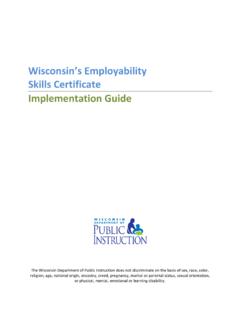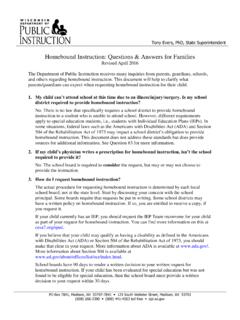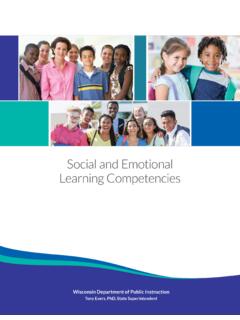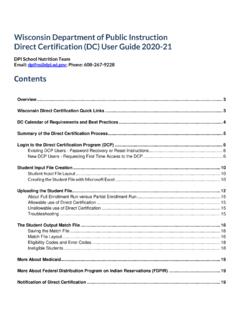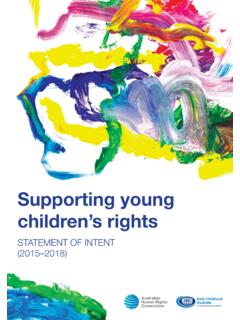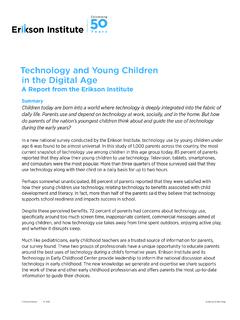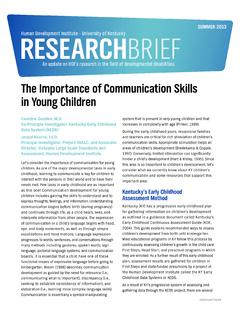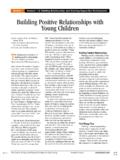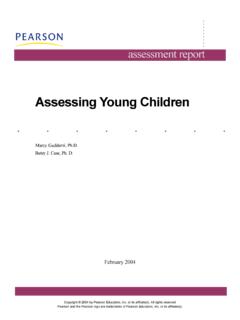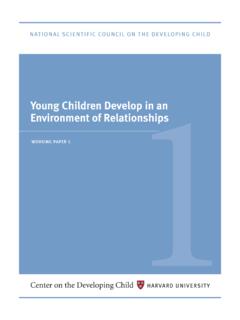Transcription of TIPS FOR SUPPORTING YOUNG CHILDREN WHO ARE …
1 TIPS FOR SUPPORTING YOUNG CHILDREN WHO ARE homeless . An increasing number of families with YOUNG CHILDREN have lost their jobs and even their homes due to socio-economic conditions brought about by the recent recession. The number of identified homeless CHILDREN and youth increased nearly 10 percent over the last three years. Wisconsin schools reported 10,955 students who were homeless during the 2008-2009 school Early childhood professionals in schools, child care, Head Start, and other programs that serve YOUNG CHILDREN and their families, can play a vital role in SUPPORTING families who are now struggling with poverty and homelessness. Family Circumstances Each homeless or highly mobile situation is unique. While most families are homeless due to a lack of affordable housing, there are other factors that can contribute to a family becoming homeless or having to move frequently. The personalities of each child and family member, their personal history, their ethnic backgrounds, and the neighborhood where they live all impact how CHILDREN and other family members respond to their living situation.
2 Therefore, the first step in determining what resources are needed for a child or family is to learn as much as possible about their particular situation. Not only will this initial assessment assist you in making appropriate decisions about how to best help the child, but it can also become the foundation for an ongoing relationship with the child and the family. A child's success in any learning environment depends on a relationship of mutual trust, and open and honest communication. Indicators of Need Being homeless is often a very complex situation for both the child and the family. Classroom teachers, family support staff, case workers, and others providing support must be alert to indicators of need, but also be cautious about making assumptions or pre- judging the situation when inquiring about the family's living situation and assessing their needs. The list of indicators below can assist in identifying possible needs.
3 MOBILITY INDICATORS ECONOMIC INDICATORS. * History of attending multiple early education programs * Wearing the same clothes on consecutive days * Lack of birth records * No extra clothing or personal items * Hesitancy about what address to use * Poor hygiene * Frequent absences * Inappropriate clothing based on weather * Inability or difficulty when contacting the parents or relatives * Malnutrition/chronic hunger * Avoidance of field trips * Concern for safety of belongings 1. TIPS FOR SUPPORTING YOUNG CHILDREN WHO ARE homeless . SOCIAL/EMOTIONAL INDICATORS PHYSICAL INDICATORS. * Difficulty or avoidance in making friends * Poor health (such as persistent sores or skin rashes). * Poor self-esteem * Unattended medical needs * Extreme shyness * Respiratory problems such as asthma * "Old" beyond years * Extreme fatigue (falls asleep frequently). * Fear of abandonment * Difficulty trusting people * Immediate gratification of needs EDUCATIONAL INDICATORS.
4 * Concern for safety * Extremely short attention span * Unexplained aggression * Unexplained developmental delays * Protective of parents * Lack of language proficiency * Clinging behavior * Anxiety when leaving the program each day Every child and family's situation is unique. CHILDREN who have a more permanent residence may also have some of the indicators listed above. However, CHILDREN of families who are highly mobile and homeless typically have multiple indicators and their needs are often more intense than housed CHILDREN . Intensity of needs can be impacted by any of the factors listed below. 1. Situational or Generational Homelessness Some families may have a history of being homeless over multiple generations. CHILDREN from chronically homeless situations face increased barriers to their academic success. On average, CHILDREN are homeless ten months at a time, or an entire school year.
5 5. 2. Physical and Mental Health CHILDREN in homeless situations often have a higher incidence of health related problems. In some cases the parent(s), as well as the child, may have problems with physical and/or mental health. Nationwide, over one-quarter of all CHILDREN (26 percent) and one-third of CHILDREN under age five (33 percent) became ill more often during episodes of homelessness.. Roughly half of school-aged CHILDREN (47 percent) and twenty-six percent (26 percent) of CHILDREN under age five suffer emotionally from depression, anxiety, or aggression after becoming homeless . Multiple stressors make problems worse: CHILDREN are more likely to suffer emotionally during homelessness if they become ill, are frequently absent from school, or are chronically homeless . At times, these negative feelings can be dangerous suicidal tendencies are common among homeless CHILDREN over the age of five.
6 2. TIPS FOR SUPPORTING YOUNG CHILDREN WHO ARE homeless . The emotional impact of homelessness is an additional burden for CHILDREN . Those who suffer from depression or anxiety will have greater difficulty in school; those who react with anger and aggression will only become further isolated from their peers. In the end, these CHILDREN lose out on their childhood something they can never regain. 6. 3. Violence in the Family or Neighborhood Domestic violence may be the reason that a family finds themselves in a homeless situation. According to parents, nearly half of homeless school-aged CHILDREN (47 percent), and more than one-quarter of those under five years of age (29 percent), have witnessed domestic violence in their household. 6. 4. Educational History of the Parent(s). homeless parents often have lower rates of high school diploma or GED attainment as compared to housed parents. Forty-one (41 percent) do not have a high school diploma, and the typical homeless parent reads at a sixth grade level.
7 They often feel unprepared or too intimidated to become involved in their child's schooling. 6. Information about each family will be helpful to determine the strengths and resources they already have as well as what may be needed. However, this information must but be kept confidential. Written authorization should be obtained from the parents before sharing information with other agencies or support staff. A sample authorization form is provided in Appendix A. SUPPORTING & INVOLVING FAMILIES. Research shows, especially for CHILDREN from families in poverty, that achievement in school is strongly linked to the family's involvement in the child's learning process. The Harvard Family Research Project makes the case that family involvement can predict a child's academic achievement and social development including: 5. The child's social competence;. Cognitive development;. Communication skills.
8 Literacy development;. Vocabulary growth;. Expressive language;. Comprehension skills; and Positive engagement with peers, adults, and learning. 3. TIPS FOR SUPPORTING YOUNG CHILDREN WHO ARE homeless . Family Resources and Protective Factors In an effort to identify a feasible approach to child abuse and neglect prevention, the Center for the Study of Social Policy developed a host of strategies that early care and education programs can use to support and strengthen families. Protecting CHILDREN by Strengthening Families: A Guidebook for Early Childhood Programs was developed to integrate effective prevention strategies into existing child care and education systems. 3. In keeping with the goal of focusing on the family's strengths instead of deficits, the Strengthening Families approach uses a model of building resiliency rather than reducing risk. Their research revealed several factors that contribute to a family's ability to provide a healthy and safe environment for their child.
9 While this study was concerned specifically with lowering incidences of child abuse and neglect, the identified protective factors may also be linked to other positive outcomes for CHILDREN . These protective factors include parental resilience; an array of social connections; adequate knowledge of parenting and child development; and substantial support in times of need (including access to necessary services such as mental health, medical care, food, etc.). The Strengthening Families program offers strategies for building protective factors. Key strategies that exemplary programs use are: Facilitate friendships and mutual support between parents;. Strengthen parenting skills;. Respond to family crises;. Link families to services and opportunities;. Facilitate CHILDREN 's social and emotional development;. Observe and respond to early warning signs of child abuse and neglect; and Value and support parents.
10 Through a process of program assessment and staff training, early childhood programs can become skilled at helping parents build protective factors. In addition to employing the strategies described above, exemplary programs also include the following practices: Build a respectful staff culture;. Support parents as leaders;. Create a welcoming, safe space for parents;. Engage fathers as well as mothers in parenting activities;. Form positive relationships with child welfare personnel when CHILDREN are placed out of home ;. Provide family support services;. Provide mental health consultation; and Support families whose CHILDREN have special educational needs. 4. TIPS FOR SUPPORTING YOUNG CHILDREN WHO ARE homeless . Involving Families A series of briefs by the Harvard Family Research Project 8 summarizes the latest evidence-based research on effective parent involvement. The first briefs focus on the linkages between family, early childhood education settings, and schools.


